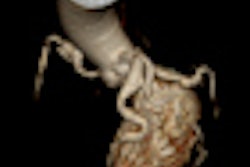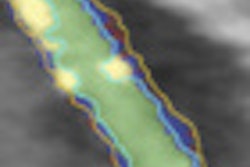
NEW YORK (Reuters Health), Dec 15 - Non-enhanced CT for calcium detection is a reliable way to exclude obstructive coronary artery disease in patients with chest pain, researchers report in the December issue of the American Journal of Cardiology.
Although CT angiography (CTA) is a well established option for evaluating patients with chest pain, particularly when stress tests are inconclusive or not feasible, "concerns about the radiation and contrast exposure" have led researchers to look for other diagnostic techniques, Dr. Koen Nieman and colleagues from Erasmus Medical Center, Rotterdam, the Netherlands explain.
They continue, "Although mostly used for risk stratification, coronary calcium (detected with regular CT) also yields diagnostic value to exclude obstructive coronary artery disease, which has been demonstrated in stable and acute chest pain, and unexplained heart failure."
The researchers studied 471 consecutive patients with new stable chest pain to compare the effectiveness of coronary calcium scores (CCS), CTA, and exercise electrocardiography (XECG) for detecting obstructive coronary disease.
In 8 patients (1.7%) neither CCS nor CTA was possible. In an additional 8, CTA could not be performed for various reasons. All of the calcium scans were successful, while three CTAs failed. XECG was not possible in 48 patients (10.2%) and was inconclusive in 140 of 423 patients (33%).
Ninety-eight patients underwent catheter angiography, with 57 found to have at least 50% diameter obstruction.
Overall, 175 patients (37%) had a negative CCS. Three of these (2%) had significant CAD on CT angiograms, only one of which was confirmed by quantitative angiography.
In patients with a high CCS (Agatston >400; n = 65), CTA could exclude obstructive CAD in no more than four (6%). CT was more often diagnostic in patients with a low-intermediate CCS (10 to 400; n = 175), and could rule out obstructive CAD in 56% of patients.
Few cases of obstructive disease were detected in patients with a low CCS (<10; n = 48), although these patients had evidence of atherosclerotic disease.
Overall, 42% of patients had positive CT angiograms. These patients had significant stenosis on quantitative angiogram more often when exercise electrocardiogram was also positive (p = 0.034).
For patients with diagnostic results for all tests, the sensitivity and specificity to detect significant coronary stenosis were 100% and 16% for CCS >0, 82% and 64% for CCS >100, 97% and 36% for CTA, and 70% and 76% for XECG, respectively.
Debate continues over which type of tests are preferred for the workup of suspected CAD: functional, or anatomical. "Although XECG is considered more cost effective, it has poor diagnostic performance," the researchers note.
"Similar to a negative stress test result, a negative CCS also has an excellent prognosis," they add. "This suggests that a negative CCS could suffice to rule out obstructive CAD without the need for further testing."
Am J Cardiol 2009;104:1499-1504.
Last Updated: 2009-12-14 15:50:29 -0400 (Reuters Health)
Related Reading
Combining calcium score with SPECT results improves cardiac risk prediction, November 3, 2009
AMA releases final calcium, CCTA codes, October 8, 2009
Symptomatic patients with zero CT calcium scores still have cardiac events, October 2, 2009
Coronary CTA beats calcium scoring for short-term prognosis, August 14, 2009
Coronary artery calcium independently predicts risk in CAD patients, July 29, 2009
Copyright © 2009 Reuters Limited. All rights reserved. Republication or redistribution of Reuters content, including by framing or similar means, is expressly prohibited without the prior written consent of Reuters. Reuters shall not be liable for any errors or delays in the content, or for any actions taken in reliance thereon. Reuters and the Reuters sphere logo are registered trademarks and trademarks of the Reuters group of companies around the world.



















